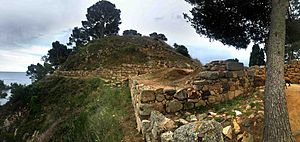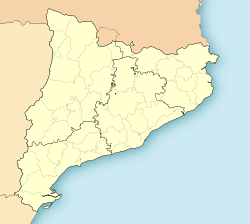Castell de la Fosca facts for kids
|
Poblat ibèric de Castell
|
|

entrance to the Castell de la Fosca
|
|
| Alternative name | Iberian Town of Castell |
|---|---|
| Location | Cala de Castell, Palamós, Catalonia, Spain |
| Region | Iberian Peninsula |
| Coordinates | 41°51′37″N 3°9′32″E / 41.86028°N 3.15889°E |
| Type | settlement |
| History | |
| Founded | 6th century BC |
| Abandoned | 1st century AD |
| Cultures | Iberian Indigetes |
| Site notes | |
| Archaeologists | Lluís Barceló i Bou |
| Condition | ruin |
| Ownership | Generalitat de Catalunya |
| Management | Archaeology Museum of Catalonia |
| Public access | yes |
Castell de la Fosca, also known as Punta del Castell, is an ancient town built by the Iberians. It sits on a rocky hill overlooking the sea. You can find it at the north end of Platja de Castell beach, about 2 kilometers (1.2 miles) east of Palamós. This area is part of the beautiful Costa Brava in Catalonia, Spain.
People lived here for a very long time, from around 600 BC until about 100 AD. The town was well-protected by strong walls and two square towers. Today, you can still see parts of these ancient structures.
Contents
Discovering the Past
Archaeologists have been studying Castell de la Fosca for many years. The first digs happened in the 1930s and 1940s. More recently, new excavations started in 2001 and are still ongoing.
What Archaeologists Found
These experts have made exciting discoveries at the site. They found 64 pits used for storage and two large cisterns for holding water. They also uncovered many everyday items, including:
- Pottery pieces
- Amphorae (large jars for liquids), some made locally and some imported
- Millstones for grinding grain
- Weights for fishing nets
- Lamps for light
- Tools for farming
- Even ancient surgical instruments!
They also found old coins, pieces of bronze, and writings in the Iberian language. The bases of two columns were also discovered, showing that some buildings had grand entrances.
Life in the Iberian Town
The items found at Castell de la Fosca tell us a lot about the people who lived there. They were likely part of the Indigetes tribe, an Iberian group.
Daily Life and Work
The tools and storage pits show that farming was important. The fishing net weights mean people also fished in the nearby sea. The imported amphorae suggest they traded with other groups, bringing goods from far away. The coins show they had a system for buying and selling.
Protecting the Town
The strong walls and towers were very important for safety. They helped protect the town from attacks. Living on a rocky hill also gave them a good view of the sea and land, making it easier to spot danger.
Why is Castell de la Fosca Important?
This ancient site helps us understand the Iberians, who lived in Spain before the Romans arrived. It shows how they built their towns, what they ate, how they worked, and how they protected themselves. It's like a window into a very old world!
Gallery
See also
 In Spanish: Poblado íbero de Castell para niños
In Spanish: Poblado íbero de Castell para niños




